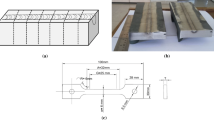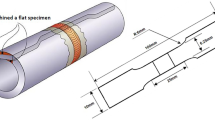Abstract
Tungsten inert gas (TIG) welded joints between Zircaloy-4 and stainless steel 304L have been studied by scanning electron microscope (SEM) having energy dispersive system (EDS) as an attachment. Intermetallic compound Zr(Cr, Fe)2 and Zr2Fe–Zr2Ni eutectic phase have been observed in the molten zone. The surface area occupied by intermetallic compound Zr(Cr, Fe)2 is about twice compared to Zr2Fe–Zr2Ni eutectic phase. The shape of the intermetallic compound is rod like. The phases were also identified by using X-ray diffraction (XRD) technique. EDS and XRD results are quite in agreement.
Similar content being viewed by others
Explore related subjects
Discover the latest articles, news and stories from top researchers in related subjects.Avoid common mistakes on your manuscript.
Introduction
Zircaloy-4 is used as cladding material for fuel element in nuclear thermal reactors due to its several attractive properties like low neutron absorption cross-section, excellent corrosion resistance and good mechanical properties at elevated temperature [1]. Stainless steel is used as a structural material in nuclear reactors. The interaction of these materials could take place in case of an accident when temperature is raised suddenly. The interactions between stainless steel and Zircaloy have been studied by many authors in the past and results have been published in the literature [2–6]. These interactions between stainless steel-304L and Zircaloy-4 were produced by solid state diffusion bonding. Mukherjee and Panakkal [7] studied interaction occurred between SS-302 spring and Zircaloy-4 during TIG welding of small diameter experimental nuclear fuel pin and correlated high hardness of the diffusion zone with the formation of intermetallics. However, composition and density of the phases were not reported. Formation of defects, i.e., cracks/microcracks and microfissures were also observed. The morphology, structure and hardness of different phases in the welded region were remained unknown.
Ahmad et al. [8] characterized the phases formed in the molten zone of electron beam welded joint of Zircaloy-4 and stainless steel 304L and observed reduction in the brittle intermetallic Zr(Cr, Fe)2, the main phase responsible for the nucleation of cracks. Zhou and Zhou [9] studied the microstructure of explosive welded joints of Zircaloy-4 and stainless steel and observed the only crystalline phase Zr(Cr, Fe)2 with hexagonal structure and concluded that welded joints could be bent and rolled without crack formation. Kleykamp and Pejsa [10] observed different phases while studying the samples taken from the molten core region of the damaged Three Miles Island-2 (TMI-2) reactor.
Welding is very important process for manufacturing the components and parts of different materials. TIG welding is commonly applied in most of the structures. There is only one report on TIG welding of dissimilar/incompatible materials like Zircaloy-4 and stainless steel 302, which did not confirm type, structure of phases, their shape and relative density. The aim of the present investigation is to study the detailed microstructure, phases and morphology of the molten zone and heat affected zones (HAZs) of the TIG welded joints of the Zircaloy-4 and stainless steel 304L and to characterize the phases by EDS and XRD and their effect on the microhardness.
Experimental
The nominal composition of both the alloy is given in Table 1. Samples of the size 2 × 1 × 0.3 cm3 were cut from the sheet of 304L and Zircaloy-4. Joining sides of both the alloys were polished on lapping machine using the diamond paste down to 0.25 μm. Butt joints were made using the TIG welding technique. The filler metal used for welding was stainless steel 304L. The TIG welding was performed using machine voltage of 30–60 V and current 12–15 A. The flow of Ar gas was 15 l/min. The welding time was about 60 s. After TIG welding the samples were polished and etched chemically in a solution of H2O2:HNO3:HF with a volume ratio of 6:6:1. The microstructure of the molten zone was investigated by scanning electron microscope (SEM) and the composition of the phases were determined using the energy dispersive system (EDS) attached with SEM. Phases were also identified with XRD using CuKα1 line λ = 1.54051 Å. Microhardness values of different phases were measured using a load of 1.96 N at room temperature.
Results and discussion
SEM micrograph with secondary electron image (SEI) of the molten zone is shown in Fig. 1, which indicates two distinct phases. Backscattered electron image (BEI) for composition, shown in Fig. 2 at high magnification, also clearly reveals two phases. Point analysis of these phases indicates that one phase is rich in Zr, Fe and Ni and the other is enriched in Zr, Cr and Fe. The concentration of these elements varies from point to point and the average content of several points is given in Table 2. The tentative phase diagrams of the ternary systems Zr–Fe–Cr and Zr–Fe–Ni, given in the literature [10] at 1000 °C, are shown in Fig. 3. Our composition of the Zr, Cr and Fe enriched phase corresponds to the phase Zr(Cr, Fe)2 and Zr, Fe, Ni, rich phase correspond to Zr2Fe–Zr2Ni eutectic phase. These phases have already been characterized by [8] in the molten zone of the electron beam welded specimens of Zircaloy-4 and SS-304L. The density of the intermetallic compound Zr(Cr, Fe)2 in the molten zone is about twice that of Zr2Fe–Zr2Ni eutectic phase in the TIG welded specimen. On the other hand the intermetallic compound Zr(Cr, Fe)2 was observed only in the region formed in the molten zone near stainless steel and Zr2Fe–Zr2Ni eutectic in rest of the molten zone with dendritic structure in EBW specimen [8]. The dendritic structure is believed to create higher solidification cracking resistance [11]. The hardness values of the Zr(Cr, Fe)2 is about three times higher compared to the hardness value of Zr2Fe–Zr2Ni eutectic phase. These microhardness values are in good agreement with the values already measured for these phases by Ahmad et al. [8] in case of electron beam welding. The density of the Zr(Cr, Fe)2 is low near the Zircaloy-4 side compared to rest of the molten zone. SEM micrograph showing the density of the Zr(Cr, Fe)2 in the fusion zone, very near to Zircaloy-4, is shown in Fig. 4. The reason of low density in this area is the less availability of Cr and Fe and more availability of Zr. A Cr rich and Ni depleted region or layer is not observed in the HAZs in the stainless steel that the authors [8, 12] observed on the side of stainless steel 304L in the joints of Zircaloy-4 and stainless steel 304L produced by electron beam welding and diffusion bonding. The composition of the HAZs is given in Table 2, which also shows minute change in the concentration of Ni and Cr compared with the nominal composition of the SS 304L. This may be due to the fact that the diffusion of Fe, Ni and Cr has been taking place from the filler material towards the stainless steel and Zircaloy-4 and also diffusion of Fe, Cr and Ni has been taking place from the large area of the heat affected region in the stainless steel 304L. HAZ near the fusion zone in stainless steel contains very small amounts of Zr and Sn and HAZ near the molten zone in Zircaloy-4 also contains small quantity of Cr, Ni and Fe. The width of the HAZ is about 0.1 mm in both the alloys from the molten zone. Grain growth is observed in HAZ on both sides of the molten zone. In order to confirm the identified phases on the basis of quantitative X-ray analysis of EDS spectra, XRD pattern was taken and analyzed. XRD analysis of the molten zone and HAZ, along with the data existing in the literature [5] for diffusion bonded couple of Zircaloy-2 and stainless steel and taken from JCPD cards is given for comparison in Table 3. XRD results show the presence of the Zr(Cr, Fe)2, Zr2Fe and Zr2Ni, Zr–Fe–Ni phases along with α-Zr phase. The Phase Zr–Fe–Ni is present in the vicinity of the molten zone in the Zircaloy-4, which is already indicated by the EDS analysis, i.e., Fe, Ni and Cr are observed in Zircaoly-4 in the HAZ. The slight variation in the measured d hkl values from the literature may be due to the small variation in the concentration of various elements. XRD results are in good agreement with the EDS results.
Conclusions
Zr(Cr, Fe)2 intermetallic compound and Zr2Fe–Zr2Ni eutectic phases have been observed in the molten zone of the TIG welded joints of the Zircaloy-4 and stainless steel 304L. The density of Zr(Cr, Fe)2 is about twice as compared to Zr2Fe–Zr2Ni eutectic phase. Hardness of the Zr(Cr, Fe)2 intermetallic compound is about three times higher compared to Zr2Fe–Zr2Ni eutectic phase. Density of Zr(Cr, Fe)2 intermetallic compound is low on the side of Zircaloy-4 as compared to stainless steel 304L.
References
Asundi MK, Banerjee S (1989) Mater Sci Fourm 48–49:201
Perona G, Sesini R, Icodemi WN, Zoja R (1966) J Nucl Mater 18:278
Shaaban HI, Hammad FH, Baron JL (1978) J Nucl Mater 71:277
Bhanumurthy K, Krisknan J, Kale GB, Banerjee S (1994) J Nucl Mater 217:67
Lucuta PGr, Patru I, Vasiliu F (1981) J Nucl Mater 99:154
Shaaban HI, Hammad FH (1978) J Nucl Mater 78:431
Mukherjee D, Panakkal JP (1995) J Mater Sci Lett 14:1383
Ahmad M, Akhter JI, Shaikh MA, Akhter M, Iqbal M, Chaudhry MA (2002) J Nucl Mater 301:118
Zhou H, Zhou B (1996) Report CNIC-01108, SINRE-0067
Kleykamp H, Pejsa R (1991) Report KFK-No. 4872
Kim HT, Nam SW, Hwang SH (1996) J Mater Sci 31:2859
Ahmad M, Akhter JI, Zaman Q, shaikh MA, Akhter M, Iqbal M, Ahmed E (2003) J Nucl Mater 317:212
Author information
Authors and Affiliations
Corresponding author
Rights and permissions
About this article
Cite this article
Ahmad, M., Akhter, J.I., Akhtar, M. et al. Microstructure and characterization of phases in TIG welded joints of Zircaloy-4 and stainless steel 304L. J Mater Sci 42, 328–331 (2007). https://doi.org/10.1007/s10853-006-1028-1
Received:
Accepted:
Published:
Issue Date:
DOI: https://doi.org/10.1007/s10853-006-1028-1








